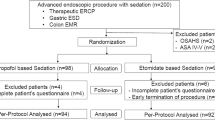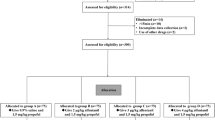Abstract
Background and aims
Sedation with propofol alone during gastroscopy has many side effects. Etomidate has advantages in terms of circulation and respiration compared to propofol. We hypothesized that etomidate plus propofol during gastroscopy would be more safe and effective than propofol alone.
Methods
Four hundred (n = 400) patients were randomly divided into a propofol group (P group) and a etomidate plus propofol group (EP group). The P group was given the first dose of 1 % propofol 1 mg/kg before gastroscopy, and the EP group was given 1 % propofol 0.5 mg/kg plus etomidate 0.1 mg/kg. Repeated doses of 10–20 mg propofol or 5–10 mg propofol plus 1–2 mg etomidate were administered to maintain an adequate level of sedation. The sedation depth was maintained by bispectral index value of 40–60.
Results
The EP group had a lower incidence of systolic hypotension (13.0 vs. 32.5 %; P < 0.0001), bradycardia (8.5 vs. 16.5 %; P = 0.0226), mild hypoxemia (6.5 vs. 18.0 %; P = 0.0007), and severe hypoxemia (2.5 vs. 10.0 %; P = 0.0031) compared to the P group. Also, the satisfaction of anesthetist and gastroscopist with EP was higher than that of P group (P < 0.0001; P = 0.018, respectively).
Conclusion
Etomidate plus propofol had few effects on respiration and circulation in patients undergoing gastroscopy and was more safe and effective than propofol alone.

Similar content being viewed by others
References
Fanti L, Testoni PA (2010) Sedation and analgesia in gastrointestinal endoscopy: what’s new? World J Gastroenterol 16:2451–2457
Cohen LB, Delegge MH, Aisenberg J et al (2007) AGA Institute review of endoscopic sedation. Gastroenterology 133:675–701
LaPierre CD, Johnson KB, Randall BR, Egan TD (2012) A simulation study of common propofol and propofol-opioid dosing regimens for upper endoscopy: implications on the time course of recovery. Anesthesiology 117:252–262
Leslie K, Clavisi O, Hargrove J (2008) Target-controlled infusion versus manually-controlled infusion of propofol for general anaesthesia or sedation in adults. Anesth Analg 107:2089
Carlson U, Grattidge P (1995) Sedation for upper gastrointestinale endoscopy: a comparative study of propofol and midazolam. Endoscopy 27:240–243
Garewal D, Powell S, Milan SJ, Nordmeyer J, Waikar P (2012) Sedative techniques for endoscopic retrograde cholangiopancreatography. Cochrane Datab Syst Rev 6:CD007274
Stokes DN, Hutton P (1991) Rate-dependent induction phenomena with propofol: implications for the relative potency of intravenous anesthetics. Anesth Analg 72:578–583
Ikazama T, Takeuchi K, Ikeda K et al (2000) Optimal propofol plasma concentration during upper gastrointestinal endoscopy in young, middle-aged, and elderly patients. Anesthesiology 93:662–669
Latson TW, McCarroll SM, Mirhej MA, Hyndman VA, Whitten CW, Lipton JM (1992) Effects of three anesthetic induction techniques on heart rate variability. J Clin Anesth 4:265–276
Gelissen HP, Epema AH, Henning RH, Krijnen HJ, Hennis PJ, den Hertog A (1996) Inotropic effects of propofol, thiopental, midazolam, etomidate, and ketamine on isolated human atrial muscle. Anesthesiology 84:397–403
Ebert TJ, Muzi M, Berens R, Goff D, Kampine JP (1992) Sympathetic responses to induction of anesthesia in humans with propofol or etomidate. Anesthesiology 76:725–733
Forman SA (2011) Clinical and molecular Pharmacology of etomidate. Anesthesiology 114:695–707
Wu J, Yao S, Wu Z et al (2013) A comparison of anesthetic regimens using etomidate and propofol in patients undergoing frist-trimester abortions: double-blind, randomized clinical trial of safety and efficacy. Contraception 87:55–62
Toklu S, Iyilikci L, Gonen C, Gunenc F, Sahin E, Gokel E (2009) Comparison of etomidate-remifentanil and propofol-remifentanil sedation in patients scheduled for colonoscopy. Eur J Anaesthesiol 26:370–376
Guler A, Satilmis T, Akinci SB, Celebioglu B, Kanbak M (2005) Magnesium sulfate pretreatment reduces myoclonus after etomidate. Anesth Analg 101:705–709
Yelavich PM, Holmes CM (1980) Etomidate: a foreshortened clinical trial. Anaesth Intensiv Care 8:479–483
Huang Y (2012) A combination of etomidate and propofol for sedation in 30 patients undergoing upper endoscopy. J Nantong Univ (Med Sci) 32:63–65
Numazaki M, Fujii Y (2005) Antiemetic efficacy of propofol at small doses for reducing nausea and vomiting following thyroidectomy. Can J Anaesth 52:333–334
Lysakowski C, Dumont L, Pellegrini M, Clergue F, Tassonyi E (2001) Effects of fentanyl, alfentanil, remifentanil and sufentanil on loss of consciousness and bispectral index during propofol induction of anaesthesia. Br J Anaesth 86:523–527
Cohen LB, Hightower CD, Wood DA, Miller KM, Aisenberg J (2004) Moderate level sedation during endoscopy: a prospective study using low-dose propofol, meperidine/fentanyl, and midazolam. Gastrointest Endosc 59:795–803
Molina-Infante J, Dueñas-Sadornil C, Mateos-Rodriguez JM et al (2012) Nonanesthesiologist-administered propofol versus midazolam and propofol, titrated to moderate sedation, for colonoscopy: a randomized controlled trial. Dig Dis Sci 57:2385–2393
Dmello D (2012) Supplemental corticosteroids after intubation using etomidate in severe sepsis and septic shock. Crit Care Med 40:2003–2004
Morel J, Salard M, Castelain C, Bayon MC et al (2011) Haemodynamic consequences of etomidate administration in elective cardiac surgery: a randomized double-blinded study. Br J Anaesth 107:503–509
Johnson KB, Egan TD, Layman J, Kern SE, White JL, McJames SW (2003) The influence of hemorrhagic shock on etomidate: a pharmacokinetic and pharmacodynamic analysis. Anesth Analg 96:1360–1368
Johnson KB, Egan TD, Kern SE, McJames SW, Cluff ML, Pace NL (2004) Influence of hemorrhagic shock followed by crystalloid resuscitation on propofol: a pharmacokinetic and pharmacodynamic analysis. Anesthesiology 101:647–659
Levitzky BE, Lopez R, Dumot JA, Vargo JJ (2012) Moderate sedation for elective upper endoscopy with balanced propofol versus fentanyl and midazolam alone: a randomized clinical trial. Endoscopy 44:13–20
Cheney FW (1999) The American Society of Anesthesiologists Closed Claims Project: what have we learned, how has it affected practice, and how will it affect practice in the future? Anesthesiology 91:552–556
Van Keulen SG, Burton JH (2003) Myoclonus associated with etomidate for ED procedural sedation and analgesia. Am J Emerg Med 21:556–558
Liu FR, Zhou HC, Liu JF (2014) Research progress in prevention of amyostasia induced by etomidate. J Anesthesiol 30(2):198–200
Doenicke AW, Roizen MF, Kugler J, Kroll H, Foss J, Ostwald P (1999) Reducing myoclonus after etomidate. Anesthesiology 90:113–119
Hwang JY, Kim JH, Oh AY, Do SH, Jeon YT, Han SH (2008) A comparison of midazolam with remifentanil for the prevention of myoclonic movements following etomidate injection. J Int Med Res 36:17–22
Mizrak A, Koruk S, Bilgi M et al (2010) Pretreatment with dexmedetomidine or thiopental decreases myoclonus after etomidate: a randomized, double-blind controlled trial. J Surg Res 159:e11–e16
Stockham RJ, Stanley TH, Pace NL, Gillmor S, Groen F, Hilkens P (1988) Fentanyl pretreatment modifies anaesthetic induction with etomidate. Anaesth Intensiv Care 16:171–176
St Pierre M, Dunkel M, Rutherford A, Hering W (2000) Does etomidate increase postoperative nausea? a double-blind controlled comparison of etomidate in lipid emulsion with propofol for balanced anaesthesia. Eur J Anaesthesiol 17:634–641
Mayer M, Doenicke A, Nebauer AE, Hepting L (1996) Propofol and etomidate-lipuro for induction of general anesthesia. Hemodynamics, vascular compatibility, subjective findings and postoperative nausea. Anaesthesist 45:1082–1084
Fragen RJ, Shanks CA, Molteni A, Avram MJ (1984) Effects of etomidate on hormonal responses to surgical stress. Anesthesiology 61:652–656
McPhee LC, Badawi O, Fraser GL et al (2013) Single-dose etomidate is not associated with increased mortality in ICU patients with sepsis: analysis of a large electronic ICU database. Crit Care Med 41:774–783
Acknowledgments
I would like to express my sincere thanks to all those who have lent me hands in course of writing this paper. I would like to express my gratitude to my workmates in Wuhan General Hospital who provided references and information. Without their help, it would have been more difficult to complete this study.
Author information
Authors and Affiliations
Corresponding authors
Ethics declarations
Disclosures
Xiang Zhou, Bi-Xi Li, Li-Min Chen, Jun Tao, Sui Zhang, Meng Ji, Ming-Chun Wu, Min Chen, Yan-Hui Zhang, Guo-Shen Gan, and Xiao-Yang Song have no conflicts of interest or financial ties to disclose.
Rights and permissions
About this article
Cite this article
Zhou, X., Li, BX., Chen, LM. et al. Etomidate plus propofol versus propofol alone for sedation during gastroscopy: a randomized prospective clinical trial. Surg Endosc 30, 5108–5116 (2016). https://doi.org/10.1007/s00464-016-4861-6
Received:
Accepted:
Published:
Issue Date:
DOI: https://doi.org/10.1007/s00464-016-4861-6




